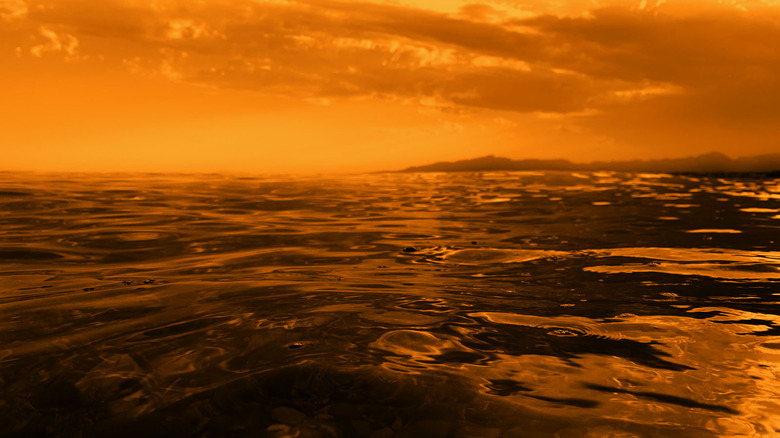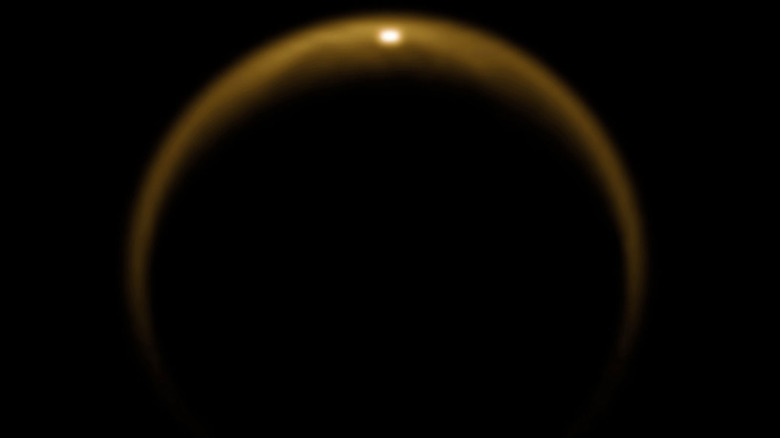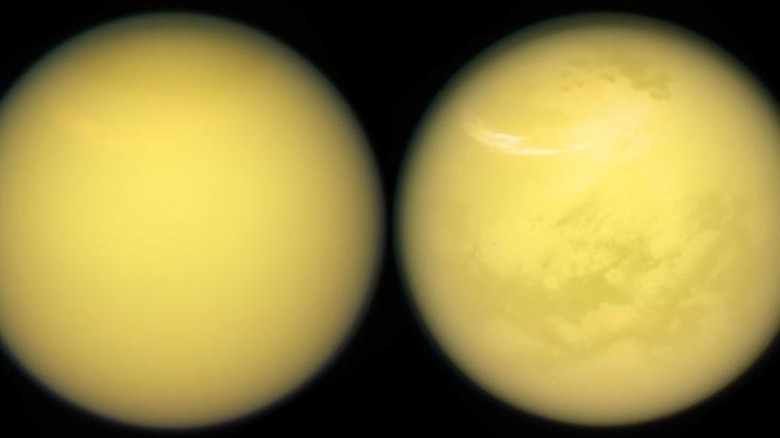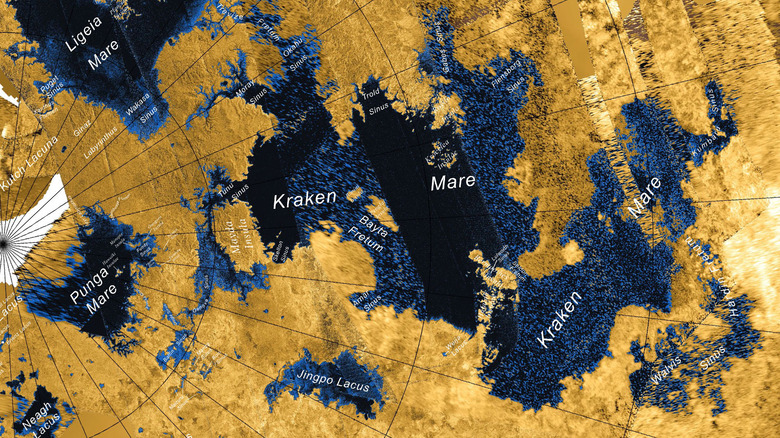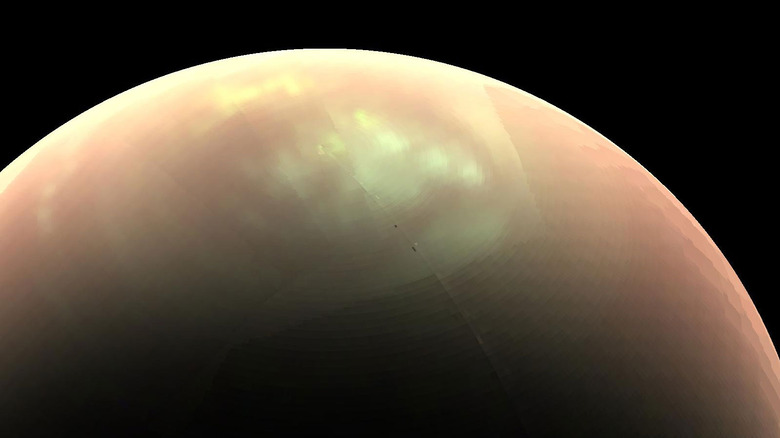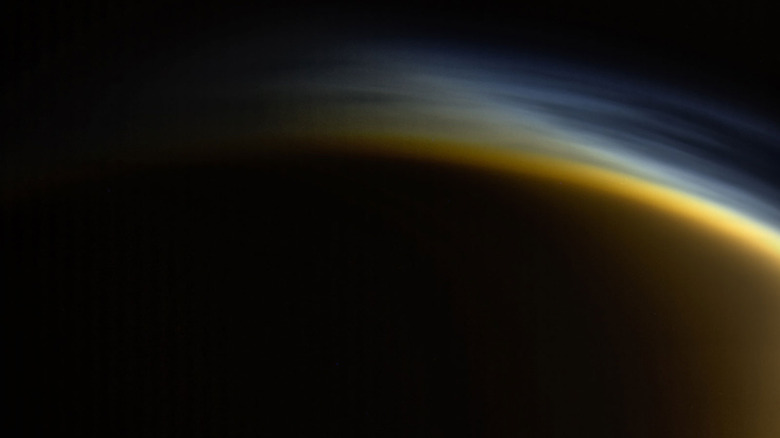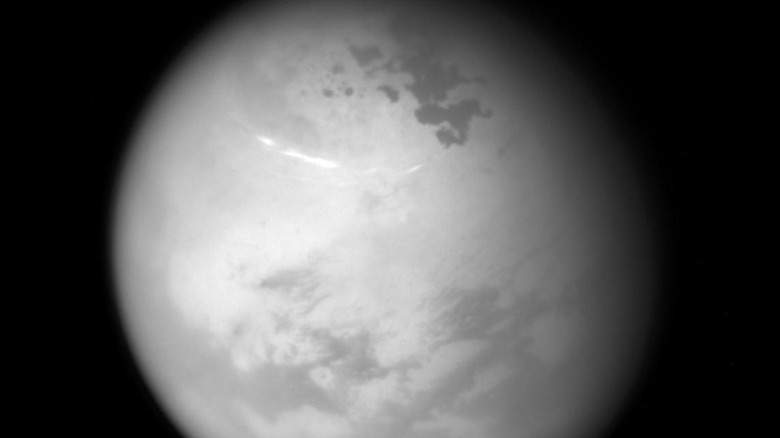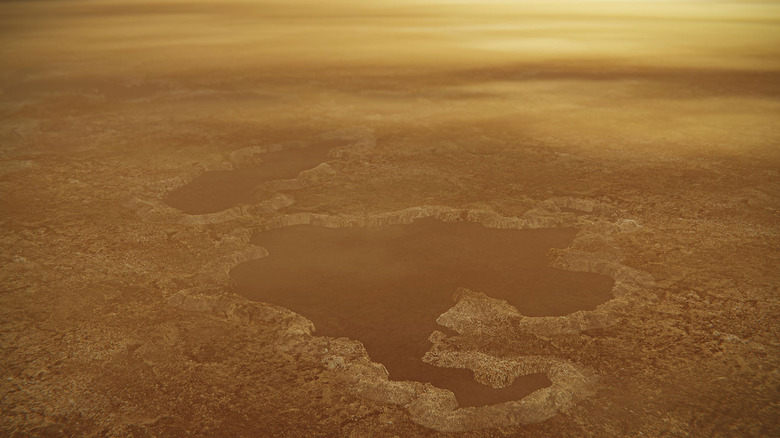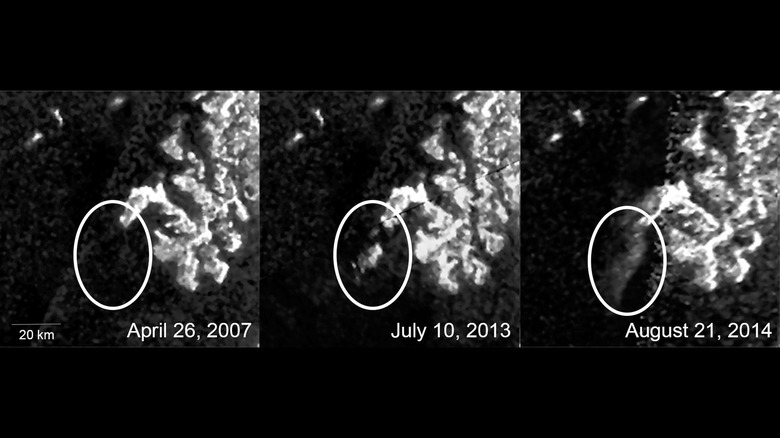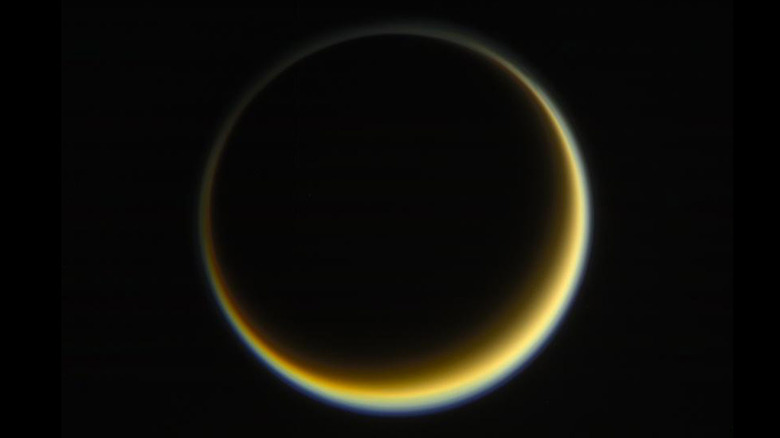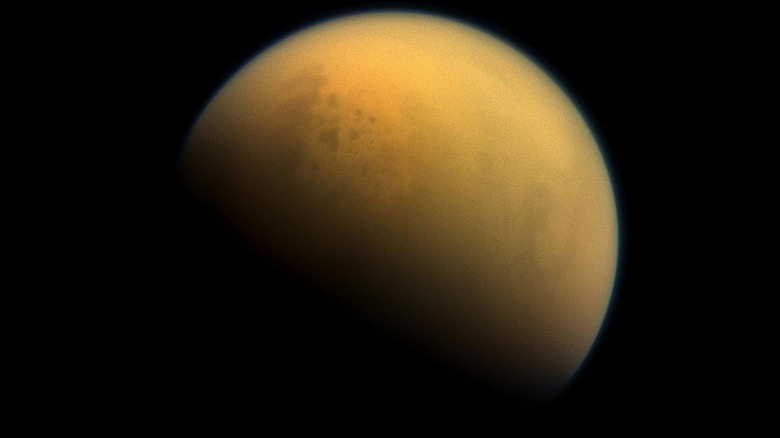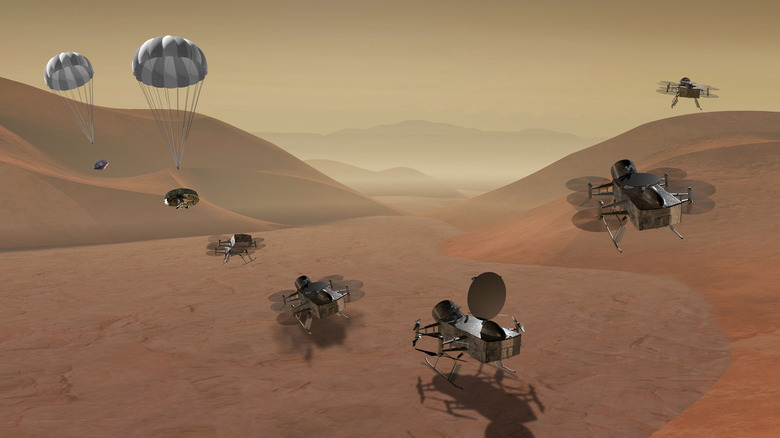Kraken Mare: The Truth About Titan's Great Sea
Saturn's moon Titan, nearly a billion miles away from Earth (via NASA), is the only other place in the entire Universe known to have weather, rainfall, and seas of liquid on its surface. But that liquid isn't water. It's methane, like the natural gas still being dug from below Earth's surface. According to the Annual Review of Earth and Planetary Sciences, Titan's seas works in much the same way as water does on Earth, sculpting the little moon's landscape and forming weather systems which, are all at once, surprisingly familiar but utterly alien.
Titan has a nitrogen-rich atmosphere filled with dense clouds, stained orange by hydrocarbon molecules, as per the National Science Foundation. In many ways, it's similar to the smog that sometimes hangs over cities like Los Angeles, with its murky yellow color caused by sunlight causing chemical reactions between hydrocarbon molecules in the atmosphere. Similar photochemical reactions happen in Titan's clouds even though, as Space.com explains, Titan only gets about 1% of the sunlight enjoyed on Earth. The result is Titan's luxurious orange clouds, making a thick haze which, according to Science, helps Titan's atmosphere trap warmth.
This surprisingly dense atmosphere is the reason why there are lakes and seas dotted around Titan's north pole, full of liquid methane and complex chemicals raining down from the sky. The largest of these seas is known as Kraken Mare and, for all scientists have learned about it, it's still overflowing with mysteries.
The Glint of Distant Seas
The Cassini-Huygens space probe has given us tantalizing glimpses below the clouds of Titan, showing sunlight shining off the southern shores of Kraken Mare. NASA explains how that glint, technically called a specular reflection, gave confirmation of Titan's seas. Hailed by NASA scientist Bob Pappalardo as an iconic image, this lucky picture was taken in 2009 as winter was ending in Titan's north, using infrared light to cut through the dense haze.
The reason this image was so exciting is that images of Titan's surface have always been elusive thanks to those clouds. A study in the Annual Review of Earth and Planetary Sciences explains how the first real look at Titan came from the Voyager 1 space probe in 1980, but Voyager was unable to see through the murky clouds. After years of waiting, this was finally the conclusive proof everyone had been waiting for — that Titan's clouds had been hiding seas of liquid all along.
There had been evidence of seas and lakes before, however. As a paper published in Nature explains, radar images showed dark patches that looked like they contained liquid, but there was still some uncertainty. Titan, it turns out, is a trickster moon, and it's tried to fool us more than once.
The Mystery of the Missing Oceans
Before Cassini, Saturn and Titan were visited by the space probes Pioneer 11, Voyager 1, and Voyager 2, according to The Planetary Society, but they all showed Titan as little more than a cloudy orange orb. Speculation was rife about what secrets Titan may be hiding beneath its haze. A popular idea, described by an American Scientist article, was that Titan's surface may be covered by deep oceans of hydrocarbons beneath its clouds. On closer examination though, as Nature explains, this idea didn't feel quite right, even back then.
All the same, as the European Space Agency shows, the idea of Titan's possible oceans stayed popular until Cassini-Huygens finally arrived there in 2005. Early images showed large, dark areas on Titan's surface that may appear, at first, like oceans. However, as a paper in JGR Planets discusses, these "seas" are filled with nothing but sand. Titan, it turns out, is much drier than Earth.
A paper published in Astronomy & Astrophysics discusses the possibility that Titan may have reservoirs of liquid methane hidden below its surface. Known as alkanofers, these would be analogous to the aquifers that keep Earth's surface hydrated with groundwater. Titan's alkanofers, however, are still purely hypothetical. The only liquid observed on Titan so far is in a series of small lakes dotted here and there on the moon's surface, and three seas in the north (via NASA). Of these, the largest and most significant is Kraken Mare.
The Kraken's Throat
One of the most thrilling things about life in the early 21st century is that, for the first time ever, there are genuine maps of the surfaces of other worlds. The USGS Astrogeology Science Center has a map of Titan's entire northern hemisphere, flecked with a myriad of small lakes and dominated by the three seas: Punga Mare, Ligeia Mare, and Kraken Mare.
NASA named Kraken Mare after the famous mythological sea monster, and that name certainly suits its spidery shape. Surrounded by several channels, called fretums and sinuses, it's divided into two by a narrow strait known as Seldon Fretum — or, as the journal Icarus calls it, "the throat of Kraken." Interestingly enough, the Kraken's throat is roughly the same size as the Strait of Gibraltar (via New Scientist), which separates the Mediterranean Sea from the Atlantic Ocean here on Earth. This strait may have strong currents that could even cause whirlpools, not unlike the ones often seen in the Naruto Strait of Southern Japan.
The currents in Kraken Mare are from the sea's tides. Titan's orbit is eccentric, meaning it isn't perfectly circular. As it orbits Saturn, the tugs of gravity cause Titan's tides. As a paper in Planetary Science Journal explains, these tides can be seen from the way sunlight glitters off the Kraken Mare's surface. It's astonishing to realize that scientists have used these "sun glitter" observations to look at actual waves on the surface of an alien sea.
Summer Storms Over Kraken Mare
The changing seasons on Titan are much slower than those of Earth. As Science Daily explains, Titan's seasons are tied to Saturn orbiting the Sun, so a cycle of seasons on Titan spans 29.5 Earth years. Summer and winter there stretch on for years, but they still cause some dramatic changes. NASA has released Titan weather reports, showing how Titan's winter sees enormous ice clouds, easily visible from space. The Titanian summer is no less dramatic.
A New Scientist article explains that the Titanian summer is a season of storms. As the seas warm in the sun, their methane starts to evaporate, potentially powering cyclones. Kraken Mare, as the largest sea by far, will have the strongest influence on these frigid storms. While not as powerful as Earth's hurricanes, scientists estimate that a cyclone on Titan could have winds as strong as a mid-sized tropical storm.
Puzzlingly though, a study published by Earth and Planetary Science Letters saw no storms in Titan's early summer. Instead, Kraken Mare's surface appeared quite calm. While it could be that scientists were looking during a period of good weather, a paper in Nature discusses another possibility. The seas of Titan could be covered by a floating film, coating Kraken Mare's surface like a permanent oil slick and stopping the sea from ever getting too rough. Not too outlandish an idea on a planet where crude oil can fall from the sky.
Monsoons and Invisible Rainbows
Titan's changing seasons occasionally bring monsoons of heavy methane rain. A New Scientist article explains how Titan's fresh-looking surface shows signs of occasional intense downpours. During Titan's downpours, up to 40 inches of rain may fall at a time, sculpting the moon's landscape even in the low gravity. As on Earth, Titan's rains are linked to its seas, particularly Kraken Mare with its huge area. A status report from NASA JPL mentions that Titan's seasons may affect the lakes dramatically, with the warmer summer evaporating enough methane to leave them dry until the winter rains can refill them again. Kraken Mare is huge by comparison, but a study in The Planetary Science Journal does find evidence that Kraken Mare has seen recent changes in sea level, though it doesn't make any suggestion that these changes are seasonal.
Either way, the seas on Titan clearly drive a lot of its weather, and the fact that Titan is one of the only places in the Solar System with rain, as NASA notes, means that it may also have rainbows. It's a charming idea, but a NASA Science article explains that the only sticking point is that rainbows need sunlight and, with Titan's dense clouds, there's very little of that at the surface. On the other hand, plenty of infrared light gets through Titan's clouds. There may be rainbows over Kraken Mare but, in infrared light, those rainbows would be invisible to human eyes.
Cloudy with a Chance of Benzene
The orange clouds of Titan are a solar-powered chemical factory. The ultraviolet in sunlight splits apart the delicate methane molecules and, as an article from ESA explains, they then join together haphazardly to form larger and larger molecules. The heaviest of these molecules are called polycyclic aromatic hydrocarbons (or PAHs for short). A paper in a journal named after them, Polycyclic Aromatic Hydrocarbons, explains how these molecules are found in car exhaust here on Earth. On Titan though, these molecules drift down from Titan's clouds, falling over Kraken Mare like snow falling over Earth's Arctic Ocean. Oily black, carcinogenic snow.
A study in the Journal of Geophysical Research took a closer look at the surface of Titan and found deposits of solid benzene accumulated on Titan's surface like toxic snowdrifts. Titan, sadly, is not a good place to build a snowman, and snowball fights are most definitely out of the question. Another article from ESA explains that plenty of Titan's hydrocarbon snow will likely end up in the seas, if not by falling onto their surfaces, then by being washed into them by rivers. As Titan's oily snow finds its way into Kraken Mare, the heavier molecules should sink down to the seafloor, coating the depths of Kraken Mare with toxic sludge.
Complex Coastal Caves
The coasts of Kraken Mare could be riddled with cave complexes. Benzene snow falls to Titan's surface, as the paper in the Journal of Geophysical Research explains, where it'll be protected from the sun's ultraviolet light. Because it won't break down, it'll slowly build up on the surface. New Scientist explains how the seas of Titan should eventually become saturated with benzene, which would then gradually build up on the coastlines in toxic mud. Once enough deposits build up, they'd start to also become eroded away by the methane rains that fall over the sea. Over time, this would lead to a jagged landscape known as a karst.
Karsts are also found on Earth where, as National Geographic explains, they're made from limestone. These stark landscapes, full of stone needles, are full of fascinating complexity. They can contain sinkholes and underground streams, as well as extensive networks of caves. Guizhou province in China is home to some dramatic karst landscapes, and a news article by CGTN shows how these karst caves can contain stalactites growing in some very unusual shapes. Perhaps the coasts of Kraken Mare may have similar karst caves, slowly growing stalactites of solid benzene.
Mysterious Magic Islands
Another of Titan's strange tricks is showing us islands that aren't really there. Details from images created from Cassini Synthetic Aperture Radar (SAR) data (shown above) look just like islands, appearing out of nowhere, only to vanish later on, seemingly dissolving away into nothing. Scientists have nicknamed these "magic islands," and they're one of the most puzzling mysteries of Titan's seas. Space.com explains that the most likely cause for these mirage-like islands is streams of nitrogen gas bubbling up from the seafloor.
As a study published in Geophysical Research Letters discusses, these magic islands have been seen in Titan's two largest seas, Ligeia Mare and Kraken Mare. The bubbling process, technically known as nitrogen exsolution, may happen when cooler rivers of methane run into the warmer sea. The sharp change in temperature causes dissolved nitrogen to suddenly be released, resulting in a mass of bubbles forming. Laboratory studies have shown that there's a good chance this is what's actually happening, but there are still other possibilities. Nature suggests the alternatives — that the magic islands could be because of something floating on the surface of the sea, or even from waves. Until there's a proper view of Kraken Mare from underneath the clouds, there's no way to know for certain.
Here Be Monsters
When talking about other planets, the idea of alien life inevitably comes up. On a place like Titan, this idea isn't as wild as it may seem, and a lot of serious astrobiology research is still being done on the subject. An expansive review in the Annual Review of Earth and Planetary Sciences makes a point of mentioning that Titan's clouds have "the potential for both prebiotic and biotic processes." In other words, something could well be alive on Titan, if not now then someday in the moon's future. But, as NASA notes, the surface of Titan is deep frozen, so cold that ice there is hard as stone. Any life on Titan would have to be very different to anything known on Earth. An audacious suggestion is that Titanian life may not use water at all.
A National Research Council report, titled "The Limits of Organic Life in Planetary Systems," gives an extensive discussion on astrobiology and what alien life might even be. Chapter six of the report considers the possibility that alien life may be able to use methane the way Earth life uses water. Hypothetical biochemistries like these are still little more than thought experiments, but the possibility is interesting enough that it's been seriously considered. If life could exist in Titan's methane, then there could be something swimming beneath the surface of Kraken Mare right now. The slightest possibility of finding life off Earth is surely worth investigating.
Setting Sail on Alien Seas
Planetary scientists, quite understandably, are eager to send robots back to take a closer look at Titan. It's a fascinating little world, unlike anywhere else, and it's bristling with enigmas waiting to be solved. Kraken Mare, as the largest known sea off Earth, is a prime target. Researchers have already designed the first boat that could ever sail on alien seas, though it wouldn't look very boat-like by Earth standards.
NPR details this, albeit with the sad realization that excited researchers once hoped a robot probe might arrive there by 2022. Designed by planetary geologist Ellen Stofan, a floating capsule could splash down onto the surface of Kraken Mare. Floating on the sea, this probe could drift with the currents, observing whatever it stumbled across. Even getting caught in a storm is an exciting prospect, just to send back the first-ever photographs of a rainstorm on another world.
An even bolder idea, described by NASA, is to send a submarine to Titan. This intrepid little craft could dive below the surface of Kraken Mare and take a detailed look at what's really down there. There would be certainly plenty for a submarine to explore — the Cornell Chronicle notes that Kraken Mare is an estimated 1000 feet deep. Exploring an alien sea like this is utterly unknown territory for all of humanity. Who knows what secrets may be hidden down there?
The Robot Dragonfly
With limited funding and resources, NASA had to make careful decisions about what kind of craft to send on its next journey to Saturn. The robot probe they eventually chose was not a boat or a submarine but a flying drone, to make the most of Titan's low gravity and thick atmosphere. Called the Dragonfly, its official website at Johns Hopkins has up-to-date information about Dragonfly's development and testing. The craft itself will be a quadcopter, flying like commercially available camera drones. Following the success of NASA's Mars helicopter Ingenuity, Dragonfly will be the second flying vehicle ever to operate on another planet. One of its many goals is to look for signs of life on Titan.
Dragonfly won't be dedicated purely to Kraken Mare, but it'll definitely give more information about it anyway. As a paper in Earth And Planetary Science Letters explains, Kraken Mare can be studied from far away. Titan's seas generate seismic waves — vibrations that echo across the moon's crust. This means that any major storm over Kraken Mare can be monitored from halfway across Titan. It is, after all, probably best for a lightweight drone to avoid gale-force winds.
Once it arrives on Titan, Dragonfly is bound to eventually pay a visit to Kraken Mare. As well as being able to unravel the mysteries of the magic islands and benzene snow, it will be truly historic to see a real image of a seashore on another world.
